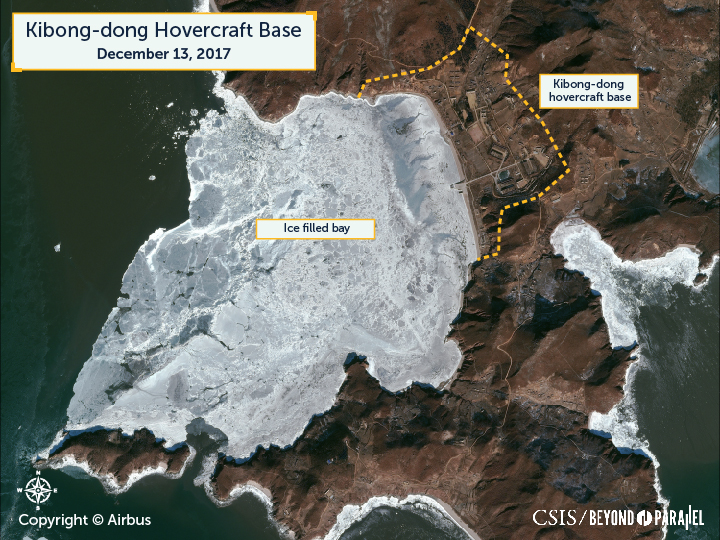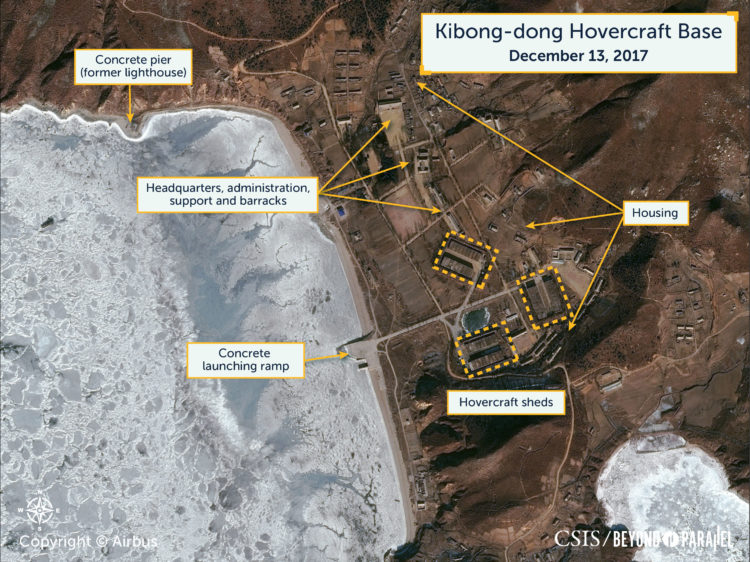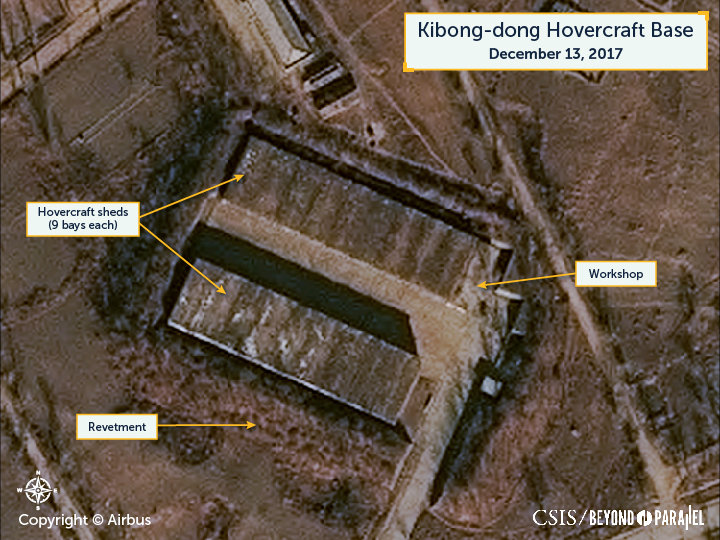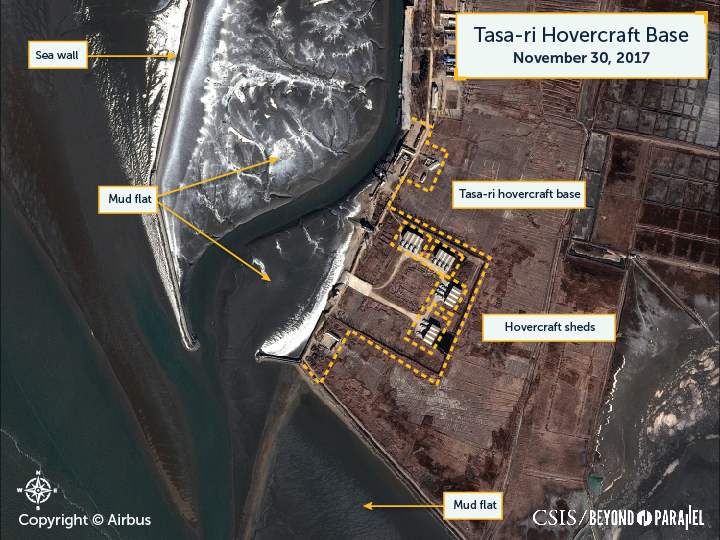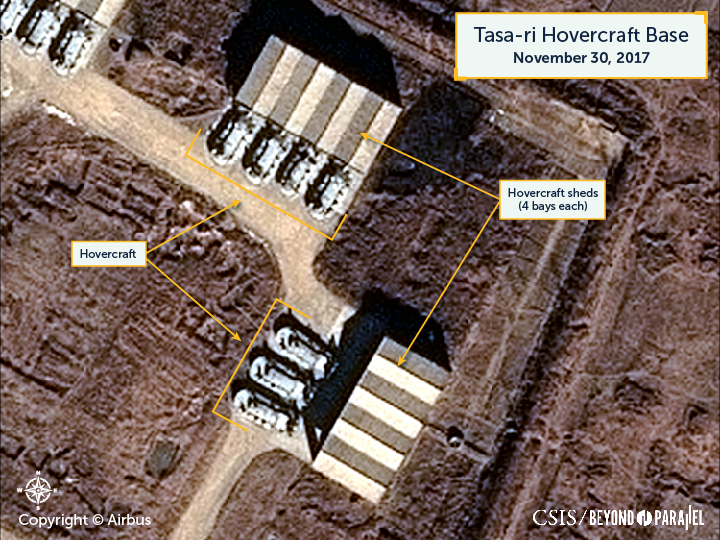
North Korean Special Operations Forces: Hovercraft Bases (Part I)
North Korea has one of the largest special operations forces (SOF) in the world with specially trained, elite soldiers numbering close to 200,000. Among these unique special operations forces today are two navy “sniper” brigades1 subordinate to the Korean People’s Navy (KPN) with one brigade deployed with the East Sea Fleet and the other with the West Sea Fleet.2
In addition to activities focused on sabotage and subversion, these units are also tasked with conducting amphibious assault landings (e.g., capturing South Korean islands in the West Sea, etc.); amphibious infiltration missions (e.g., inserting sabotage teams, etc.) along the South Korean coasts; and establishing a “second front” in South Korea’s strategic rear areas.3
Key Takeaways
- North Korean hovercraft units—a key element in supporting navy sniper brigades’ offensive operations—have evolved and become more threatening over time as a result of restructuring, modernization and construction of new bases closer to the Northern Limit Line (NLL).
- In the West Sea, the hovercraft units appear to be subordinate to a single amphibious assault command that is controlled and based separately from the navy sniper brigades.
- This amphibious assault command is subordinate to the West Sea Fleet headquarters and appears to consist of a headquarters, support elements, a number of landing craft squadrons and four hovercraft squadrons.
- Each hovercraft squadron is equipped with 16-18 hovercraft. These four squadrons are currently deployed at two bases—Kibong-dong and Tasa-ri.
- If used as a staging area for an attack, the hovercraft units from Kibong-dong could land as many as 2,700 special force troops on South Korea’s western islands within two to four hours. Units from Tasa-ri could land an additional 800 troops within 2.5 to 4.5 hours of a first wave attack.
- There is a third, newer, hovercraft base that was built at Sasŭlp’o (Namdae-ch’ŏn) during the period between 2009-2011. However, no hovercraft have been deployed there as of January 2018.
- More threatening, preliminary observations indicate a new hovercraft base is under construction further south on the west coast immediately north of the Northern Limit Line.
Overview
Special operations forces represent approximately 17 percent of the strength of the Korean People’s Army (KPA) and are uniquely structured, trained and equipped to undertake unique missions such as: sabotage of command, control, communications, computers and intelligence (C4I) facilities, port facilities, oil and gas storage facilities, airbases, and missile sites; interdiction of major lines of communications; strategic reconnaissance; assassination of key military and political personalities; conducting unconventional warfare activities in the South Korea and Japan; and more.
Up until the early-1980s, the navy sniper brigades in the KPN were limited in their ability to conduct large amphibious operations due to their organization, limited inventory of conventional and small high-speed landing craft and the shallow waters and extreme tidal swing of the West Sea.4
In order to directly address these operational limitations during the mid-1980s the KPN undertook a reorganization and expansion of the navy sniper brigades, and introduced high-speed hovercraft (a.k.a., air cushion vehicles) units to first supplement and then replace many older and less capable high-speed landing craft.5 To accommodate these new hovercraft, the KPN established two hovercraft units and constructed hovercraft bases on each coast. By the mid-1990s, the current inventory of approximately 140 hovercraft of at least two classes was reached.6 Since that time the inventory of hovercraft has remained relatively stable, however, the basing of these units has evolved and become more threatening as a result of restructuring, modernization and construction of new bases closer to the Northern Limit Line (NLL).
There are several classes of hovercraft in KPN service—most notably are the KONG BANG II and III. These two classes can carry 50 and 40 troops each, respectively, at speeds of 40-50 knots (74-92 km/h) depending upon sea conditions.
File "/nas/content/staging/korea/wp-content/uploads/2016/09/NK-Hovercraft-Classes.xlsx" does not exist.
Subordinate to the West Sea Fleet headquarters is what appears to be a single amphibious assault command that is controlled and based separately from the navy sniper brigades. This amphibious assault command is believed to consist of a headquarters, support elements, a number of landing craft squadrons and four hovercraft squadrons.7 Each hovercraft squadron is equipped with 16-18 hovercraft. These four squadrons are deployed at two bases—Kibong-dong and Tasa-ri.
Kibong-dong
Located approximately 116 km northwest of Pyongyang on the southern tip of a small peninsula, the Kibong-dong hovercraft base (39.6147°, 124.6325°) is the oldest such base on the west coast. Built during the 1980s, it occupies approximately .82 km2 (202 acres) in a shallow bay and consists of several headquarters, administration and support buildings, housing areas, three hovercraft storage facilities, testing pond (used after making minor repairs to a hovercraft’s hull) and a concrete launching ramp. On the north side of the bay is a small approximately 30-meter-by-30-meter concrete pier that originally housed a small lighthouse that was dismantled during the early 2000s and is now occasionally used for training by hovercraft units.
Each hovercraft storage facility is surrounded on three sides by a high earthen revetment, measures approximately 90-meters-by-65-meters and contains two parallel rectangular hovercraft shed buildings. Each of these sheds measures approximately 76-meters-by-22-meters and contains nine hovercraft bays that are open to the front and rear. One of the shed buildings has a small attached administration or support building. Taken together, these three hovercraft compounds can shelter a total of 52 hovercraft. The shed buildings are primarily for environmental protection and provide little, or no, protection from attack.
Due to winter icing of the bay in which the base is located, training activity is heaviest from Spring through Fall. Training activities consist of open water voyages and landing exercises primarily along northern beaches and shorelines. In recent years there has typically been one major joint landing exercise each year which, on occasion has been conducted further south along the coast. Such exercises are conducted with ground force land units, Air Force units—including paratroop air drops and airstrikes, and Navy vessels and submarines. These exercises are designed to simulate wartime landings on South Korean islands and in the strategic rear area and have included the participation of larger landing craft for infantry, tanks and artillery units.
The hovercraft sheds that exist today at the Kibong-dong base were constructed during 2000-2003. Since then, satellite imagery analysis has shown that while the sheds have remained essentially unchanged, various construction projects have been carried out at the base that have seen small buildings being razed, new structures being erected, and a gradual deterioration of the concrete pad on the north side of the bay.
The distance from Kibong-dong to the northernmost ROK island of Baegnyeong-do (백령도) is approximately 182 km and to the port city Incheon (인천) approximately 373 km. Under ideal conditions these voyages would take approximately 2 and 4 hours respectively for hovercraft operating from Kibong-dong. If all hovercraft were carrying their maximum number of troops such an attack has the potential to land 2,700 troops in an initial assault wave. Potentially, a second wave could be landed 4-8 hours later.8
Tasa-ri
Located approximately 25 km north of Kibong-dong is the Tasa-ri hovercraft base (39.8081° 124.4126°). Believed to have been built during the early-1990s as a satellite facility to the Kibong-dong base it occupies approximately .11 km2 (27 acres) within a small man-made inlet enclosed by sea walls. The facility is minimal, at best, consisting of several small headquarters, administration and support buildings, a single hovercraft storage facility, a small maritime railway with transfer table and a concrete launching ramp. Housing is likely located in the nearby town of Tasa-rodongjagu (다사로동자구) and all major maintenance is performed at either the nearby Tasa-ri shipyard or at Kibong-dong.
The hovercraft storage facility is surrounded on three sides by a tree-lined earth revetment and consists of four rectangular hovercraft sheds. Each of the sheds measure approximately 45-meters-by-22-meters and contains four open-front hovercraft bays. Thus, providing shelter for a total of 16 hovercraft. As with the Kibong-dong base, these sheds are for environmental protection and provide little or no protection from attack.
The hovercraft sheds that exist today at the Tasa-ri base were built during the 2004-2008 period. Since that time no significant changes have been observed in satellite imagery with the sheds and only a few very minor changes to the number and type of structures present at the base have been observed.
The distance from Kibong-dong to the northernmost ROK island of Baegnyeong-do (백령도) is 210 km and to the port city Incheon (인천) approximately 400 km. Under ideal conditions these voyages would take approximately 2.5 and 4.5 hours hours respectively. If all hovercraft were carrying their maximum number of troops such an attack has the potential to land an additional 800 troops to those landed by Kibong-dong hovercraft in a first wave. Potentially, a second wave could be landed 5-9 hours later.9
Together, these four hovercraft compounds at Kibong-dong and Tasa-ri can shelter a total of 68 hovercraft.
File "/nas/content/staging/korea/wp-content/uploads/2016/09/Hovercraft-Bases-Table-3-1.xlsx" does not exist.
References
- “Sniper” is a World War II Soviet honorific adopted by the Korean People’s Army to designate elite special operations units. ↩
- North Korea does not use the titles of Yellow Sea or Sea of Japan, but rather refers to these two bodies of water as the West Sea (Sohae) and East Sea (Tonghae). ↩
- Bermudez, Joseph S., Jr. North Korean Hovercraft Forces: Part 3 Sasulp’o. Longmont, CO: DigitalGlobe, June 8, 2011; Bermudez, Joseph S., Jr. North Korean Special Forces – Second Edition, Annapolis: U.S. Naval Institute Press, November 1997, pp. 194-209; Roh Chŏng-Min, “Expansion of North Korea’s Hovercraft Base Making Progress in Small but Rapid Steps,” Radio Free Asia, November 1, 2017, (in Korean), http://www.rfa.org/korean/weekly_program/c704c131c0acc9c4-d558b298c5d0c11c-bcf8-bd81d55c/satellitenk-11012017150626.html; Lee Min-Jung, “‘North Korean Hovercraft Killer’… New-generation High-speed Patrol Boat to be Deployed along NLL Early Next Year,” JoongAng Ilbo, October 30, 2017; and “Navy launches new patrol boat to counter N. Korean hovercrafts,” Yonhap, July 28, 2016, http://english.yonhapnews.co.kr/national/2016/07/28/33/0301000000AEN20160728004151315F.html. ↩
- This tidal swing can change by as much as 10 meters and exposes approximately 1,000 square miles of mudflats at low tide that strand conventional vessels but that hovercraft can easily skim across. See Walters, Sr., Kenneth R. and Traxler, Maj. Kathleen M. North Korea—A Climatological Study, Scott AFB, IL: USAF. ↩
- The term “hovercraft” is a more general name for the technical designation of “Landing Craft, Personnel, Air-cushioned” (LCPA) or “Landing Craft, Air-cushioned” (LCAC) and is used here for readability. ↩
- There may be a small number of additional hovercraft on the east coast. ↩
- Author interview data. There is considerable confusion in the open source regarding the organization of the parent unit controlling the hovercraft so the information presented here should be viewed with caution. ↩
- These estimates are the worst case and assume 100 percent serviceability and no losses during the voyage to a landing—both are unlikely to be achieved under wartime conditions. ↩
- These are based upon the same criteria as those for the Kibong-dong base above. ↩

